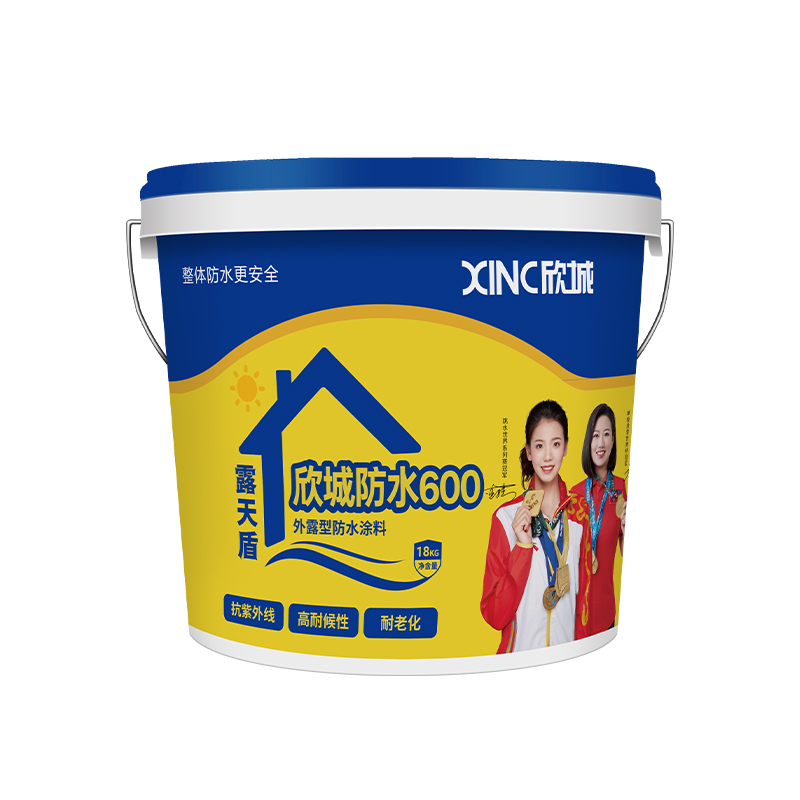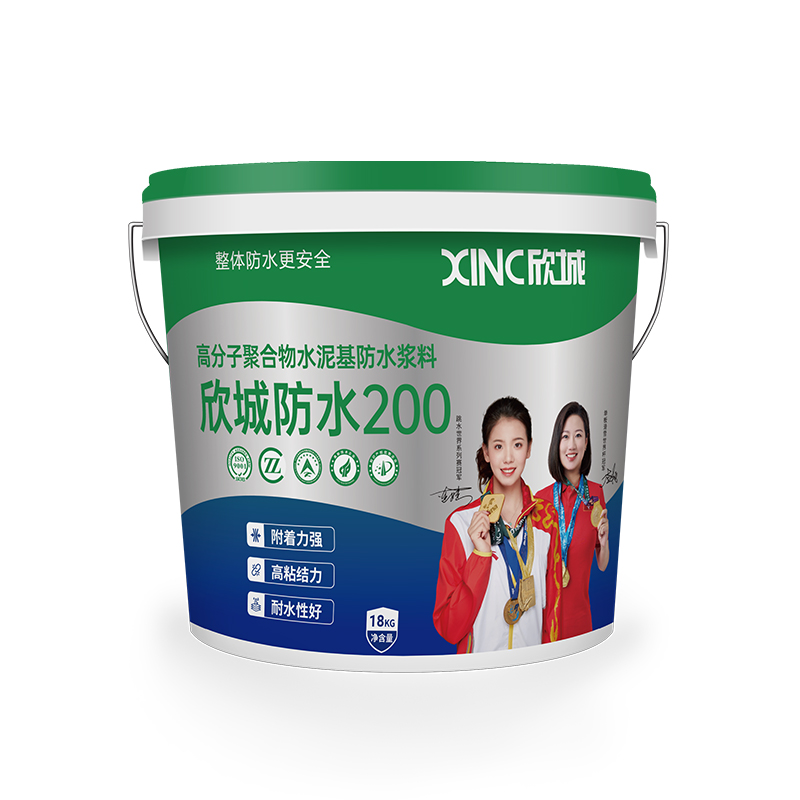Why does polymer cement waterproof coating achieve both rigidity and flexibility, providing long-lasting protection?
Release Time : 2025-10-24
As building waterproofing technology continues to evolve, single-performance materials are increasingly unable to meet the complex and ever-changing demands of projects. Traditional rigid waterproofing materials, while able to withstand certain pressures, are prone to cracking due to structural deformation. Purely flexible coatings, while ductile, can suffer from poor adhesion and inadequate durability. Polymer cement waterproof coating emerged precisely to address this contradiction. It cleverly blends the strength of inorganic materials with the elasticity of organic materials, achieving both rigidity and flexibility, making it a trusted choice for modern building waterproofing systems.
Polymer cement waterproof coating is essentially a composite system, based on cement, combined with carefully selected polymer emulsions and functional fillers. Cement, as an inorganic component, imparts the coating's exceptional rigidity and high compatibility with substrates such as concrete and mortar. When applied to walls or floors, the cement component penetrates the substrate's capillary pores, undergoing a hydration reaction and forming a strong chemical and mechanical bond, securing the coating tightly to the base layer and resisting peeling. This strong adhesion is essential for the long-term stability of the waterproofing layer, especially during facade construction, where it effectively prevents the coating from sliding or falling off due to its own weight or external disturbances.
At the same time, the addition of polymer emulsions radically changes the brittle nature of traditional cement-based materials. During the coating's curing process, these polymers form a continuous elastic network, evenly distributed between the cement crystals, like flexible "veins" within a rigid skeleton. This structure allows the coating to adapt to minor shrinkage of the base layer, expansion and contraction caused by temperature fluctuations, or slight structural deformation, allowing it to adapt without breaking. Like a resilient skin, it covers the building's surface, resisting external impact while accommodating internal stress release, effectively bridging microcracks and preventing moisture from penetrating through them.
This "combination of rigidity and flexibility" is reflected not only in the integration of physical properties but also in its adaptability to the operating environment. In environments with long-term alternations of dryness and humidity, many materials experience fatigue failure due to repeated water absorption and contraction. Polymer cement waterproof coating combines excellent water resistance with moderate breathability. It maintains the integrity of the waterproof barrier while allowing moisture to slowly escape from the base layer, preventing bubbling or delamination caused by internal pressure buildup. This balance makes the coating particularly effective in spaces with frequent humidity fluctuations, such as bathrooms, balconies, and basements.
The coating's performance during application also demonstrates its advantageous combination of rigidity and flexibility. The coating, in a paste or emulsion form, is easily applied by scraper or roller, completely covering even the most uneven surfaces. It is particularly suitable for seamless connections at complex joints such as pipe bases, wall corners, and internal and external angles. The coating produces no harmful gases during the curing process and requires no open flames or solvents, making it safe and environmentally friendly. The resulting coating exhibits sufficient hardness to withstand subsequent scratches and retains sufficient flexibility to withstand the dynamic stresses of use, providing a stable foundation for subsequent processes such as tiling and flooring.
More importantly, this combination of rigidity and flexibility extends the life of the waterproofing layer. It not only provides a reliable seal during initial construction but also maintains its performance over the building's long-term operation. Even if non-structural microcracks develop, the coating's elastic components can withstand some stretching, preventing rapid crack propagation to the waterproofing layer's surface. The stability of the cement base ensures the coating resists aging, chalking, or softening, maintaining its protective capabilities over time.
Thus, the polymer cement waterproof coating's ability to achieve both rigidity and flexibility, despite its inherent strength, stems from the deep integration of its material properties. Rather than a simple physical mixture, it utilizes scientific formulations and chemical reactions to create a composite structure that is both strong and resilient. This structure firmly "holds" the building while flexibly responding to various internal and external stresses, achieving a true "rigidity without being brittle, and flexibility without being slippery." In today's world of striving for building durability and residential safety, it's more than just a coating; it's an intelligent barrier that protects buildings from flooding and extends their lifespan.
Polymer cement waterproof coating is essentially a composite system, based on cement, combined with carefully selected polymer emulsions and functional fillers. Cement, as an inorganic component, imparts the coating's exceptional rigidity and high compatibility with substrates such as concrete and mortar. When applied to walls or floors, the cement component penetrates the substrate's capillary pores, undergoing a hydration reaction and forming a strong chemical and mechanical bond, securing the coating tightly to the base layer and resisting peeling. This strong adhesion is essential for the long-term stability of the waterproofing layer, especially during facade construction, where it effectively prevents the coating from sliding or falling off due to its own weight or external disturbances.
At the same time, the addition of polymer emulsions radically changes the brittle nature of traditional cement-based materials. During the coating's curing process, these polymers form a continuous elastic network, evenly distributed between the cement crystals, like flexible "veins" within a rigid skeleton. This structure allows the coating to adapt to minor shrinkage of the base layer, expansion and contraction caused by temperature fluctuations, or slight structural deformation, allowing it to adapt without breaking. Like a resilient skin, it covers the building's surface, resisting external impact while accommodating internal stress release, effectively bridging microcracks and preventing moisture from penetrating through them.
This "combination of rigidity and flexibility" is reflected not only in the integration of physical properties but also in its adaptability to the operating environment. In environments with long-term alternations of dryness and humidity, many materials experience fatigue failure due to repeated water absorption and contraction. Polymer cement waterproof coating combines excellent water resistance with moderate breathability. It maintains the integrity of the waterproof barrier while allowing moisture to slowly escape from the base layer, preventing bubbling or delamination caused by internal pressure buildup. This balance makes the coating particularly effective in spaces with frequent humidity fluctuations, such as bathrooms, balconies, and basements.
The coating's performance during application also demonstrates its advantageous combination of rigidity and flexibility. The coating, in a paste or emulsion form, is easily applied by scraper or roller, completely covering even the most uneven surfaces. It is particularly suitable for seamless connections at complex joints such as pipe bases, wall corners, and internal and external angles. The coating produces no harmful gases during the curing process and requires no open flames or solvents, making it safe and environmentally friendly. The resulting coating exhibits sufficient hardness to withstand subsequent scratches and retains sufficient flexibility to withstand the dynamic stresses of use, providing a stable foundation for subsequent processes such as tiling and flooring.
More importantly, this combination of rigidity and flexibility extends the life of the waterproofing layer. It not only provides a reliable seal during initial construction but also maintains its performance over the building's long-term operation. Even if non-structural microcracks develop, the coating's elastic components can withstand some stretching, preventing rapid crack propagation to the waterproofing layer's surface. The stability of the cement base ensures the coating resists aging, chalking, or softening, maintaining its protective capabilities over time.
Thus, the polymer cement waterproof coating's ability to achieve both rigidity and flexibility, despite its inherent strength, stems from the deep integration of its material properties. Rather than a simple physical mixture, it utilizes scientific formulations and chemical reactions to create a composite structure that is both strong and resilient. This structure firmly "holds" the building while flexibly responding to various internal and external stresses, achieving a true "rigidity without being brittle, and flexibility without being slippery." In today's world of striving for building durability and residential safety, it's more than just a coating; it's an intelligent barrier that protects buildings from flooding and extends their lifespan.







